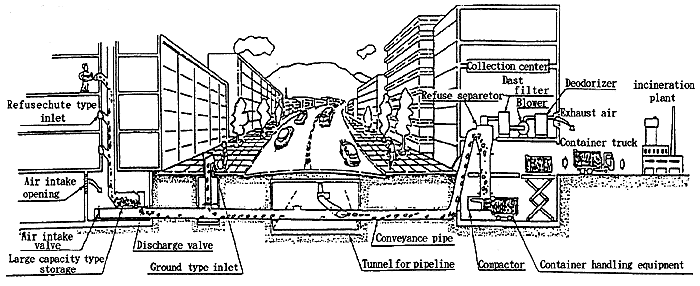Waste Treatment Technology in JAPAN
Collection, Transportation and Storage
2) Reduction of the effects of collecting vehicles to traffic and air pollution by
their exhaust gas.
3) Improvement in reduced efficiency of collection transportation due to traffic
congestion.
4) To respond to increasing quantities of wastes, the current systems must increase
all the costs, personnel, equipment and materials. In particular, this vacuum
conveyance system which can be discharged any time is evaluated high as convenient
in inhabitant questionnaires.
In an example of this system to be implemented in the MINATO MIRAI 21 (Yokohama City), it will have a pipe size of 500A, a collection district area of 186 ha, a planned refuse amount of 160 tons per day, 200 planned inlets, and a total conveyance pipe length of 13 km.
1. Purpose
The refuse vacuum sealed conveyance system has been developed to provide a breakthrough for and drastically resolve the following problems associated with the current vehicle-base collection systems.
1) The health and appearance of garbage collecting places.
2. Refuse Flow (See "Section 4. Schematic Diagram")
Refuse charged from the inlets is first stored in a storage tank and the stored refuse is then discharged at the specified times. The discharged refuse is conveyed with an air flow produced by a blower located in a collection center to a refuse separator.
3. Capacity
The standards for the Mitsubishi refuse vacuum sealed conveyance systems are listed below. In the small bore system, special shredders are provided under the refuse inlets .

4. Schematic Diagram
